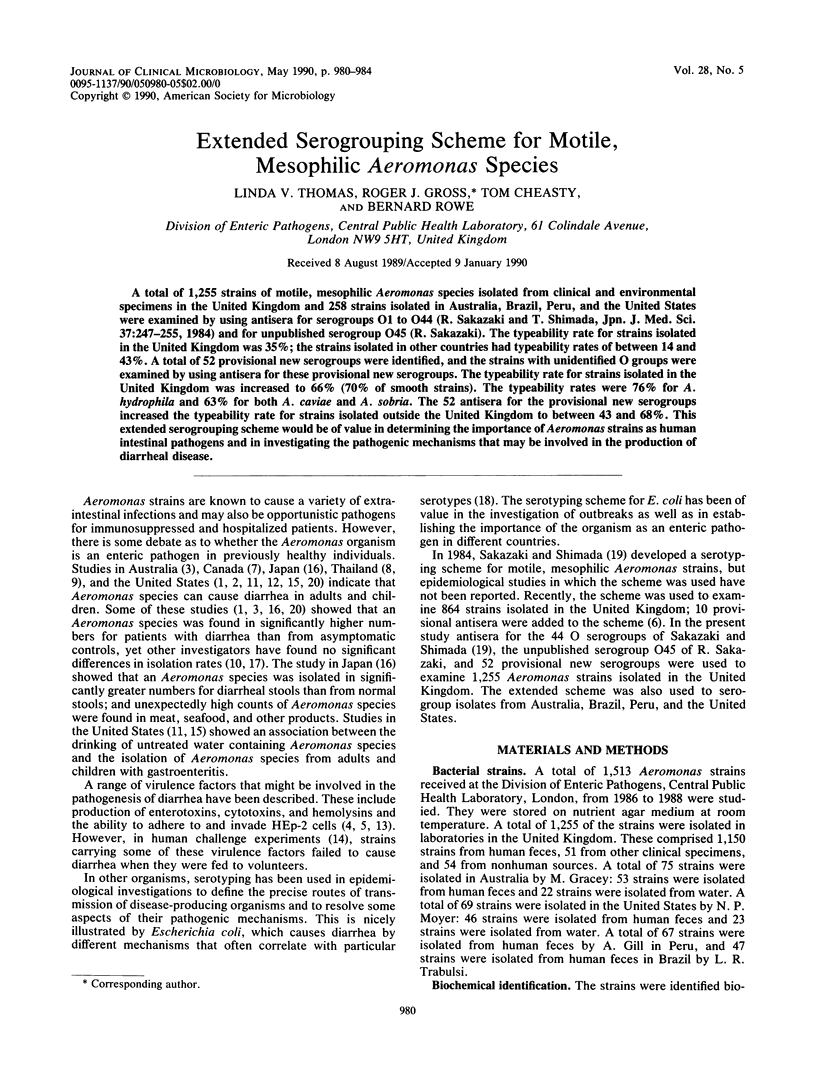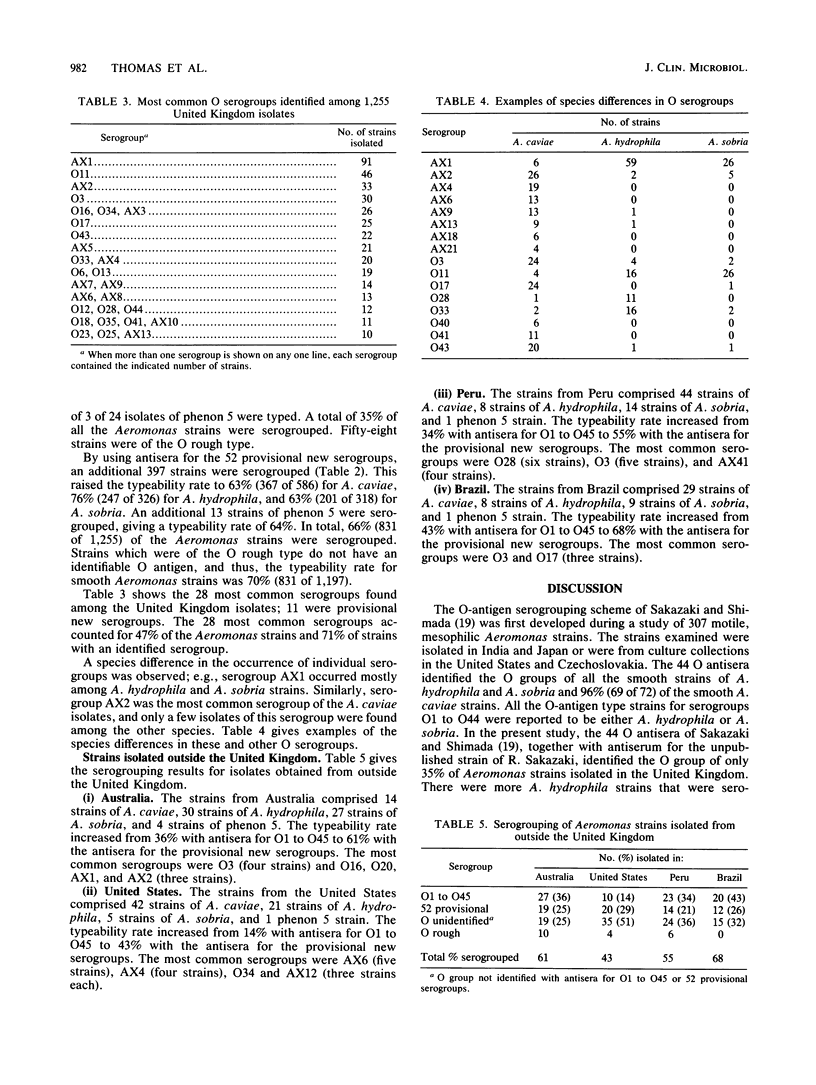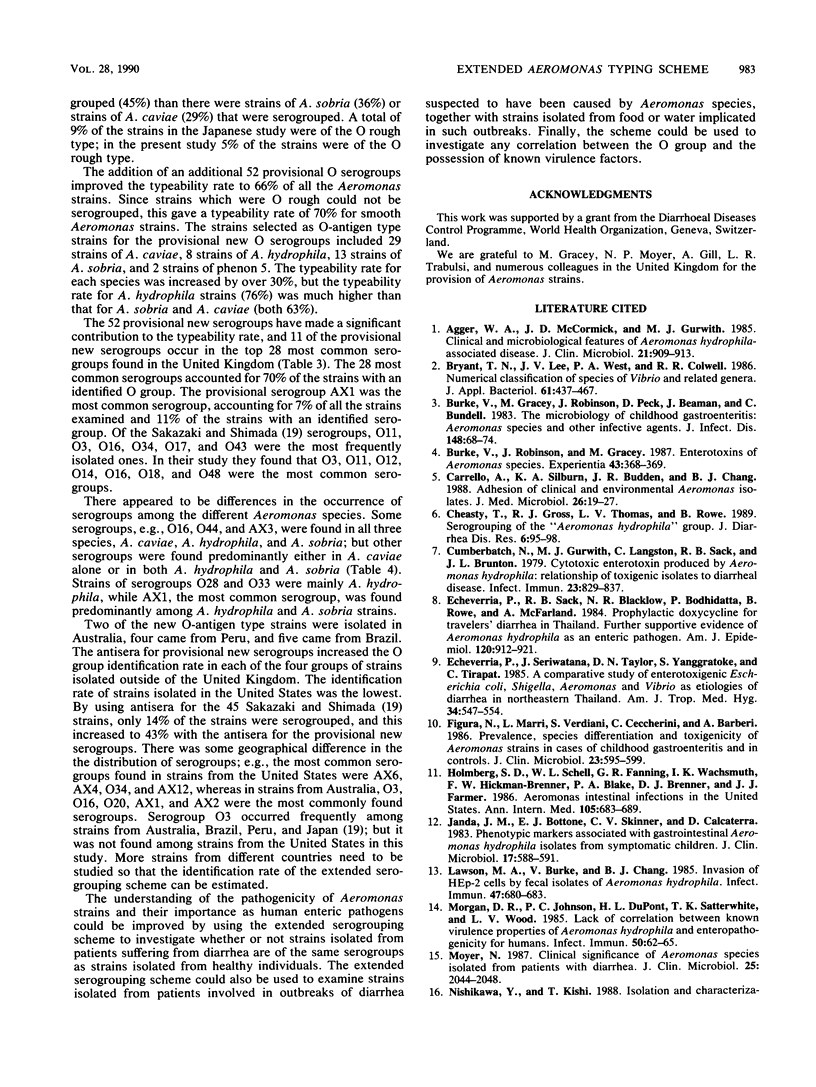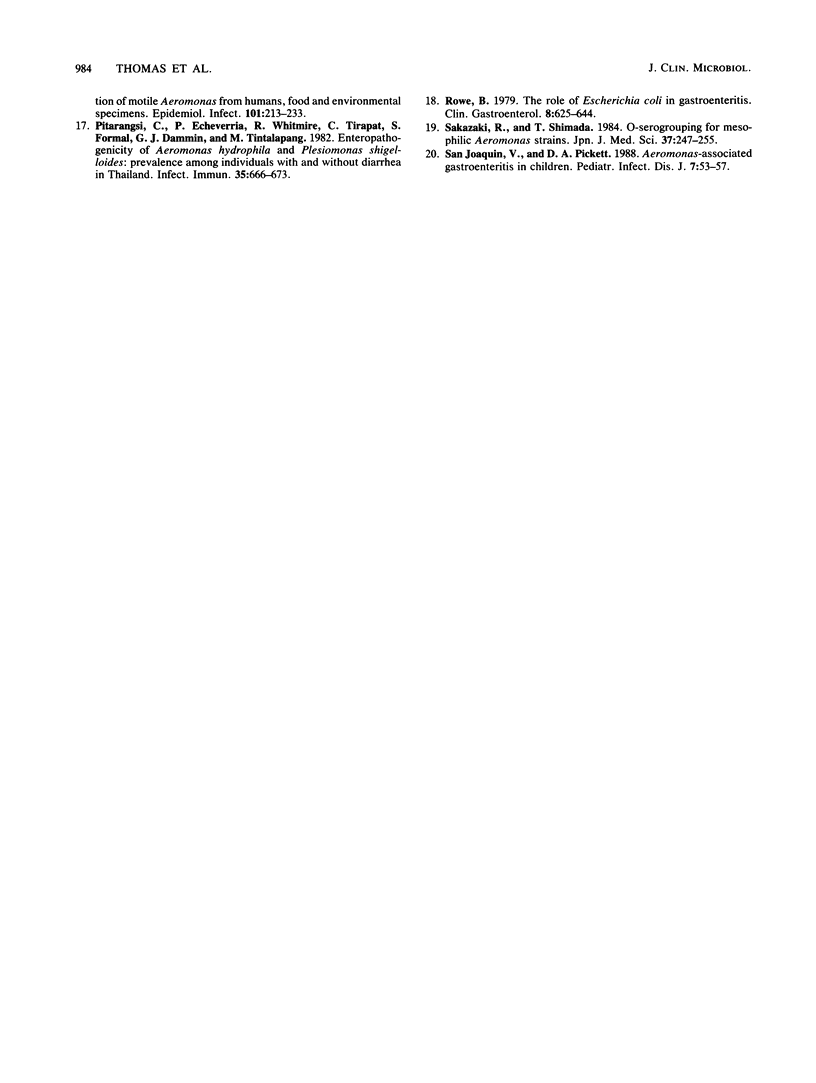Abstract
A total of 1,255 strains of motile, mesophilic Aeromonas species isolated from clinical and environmental specimens in the United Kingdom and 258 strains isolated in Australia, Brazil, Peru, and the United States were examined by using antisera for serogroups O1 to O44 (R. Sakazaki and T. Shimada, Jpn. J. Med. Sci. 37:247-255, 1984) and for unpublished serogroup O45 (R. Sakazaki). The typeability rate for strains isolated in the United Kingdom was 35%; the strains isolated in other countries had typeability rates of between 14 and 43%. A total of 52 provisional new serogroups were identified, and the strains with unidentified O groups were examined by using antisera for these provisional new serogroups. The typeability rate for strains isolated in the United Kingdom was increased to 66% (70% of smooth strains). The typeability rates were 76% for A. hydrophila and 63% for both A. caviae and A. sobria. The 52 antisera for the provisional new serogroups increased the typeability rate for strains isolated outside the United Kingdom to between 43 and 68%. This extended serogrouping scheme would be of value in determining the importance of Aeromonas strains as human intestinal pathogens and in investigating the pathogenic mechanisms that may be involved in the production of diarrheal disease.
Full text
PDF




Selected References
These references are in PubMed. This may not be the complete list of references from this article.
- Agger W. A., McCormick J. D., Gurwith M. J. Clinical and microbiological features of Aeromonas hydrophila-associated diarrhea. J Clin Microbiol. 1985 Jun;21(6):909–913. doi: 10.1128/jcm.21.6.909-913.1985. [DOI] [PMC free article] [PubMed] [Google Scholar]
- Bryant T. N., Lee J. V., West P. A., Colwell R. R. Numerical classification of species of Vibrio and related genera. J Appl Bacteriol. 1986 Nov;61(5):437–467. doi: 10.1111/j.1365-2672.1986.tb04308.x. [DOI] [PubMed] [Google Scholar]
- Burke V., Gracey M., Robinson J., Peck D., Beaman J., Bundell C. The microbiology of childhood gastroenteritis: Aeromonas species and other infective agents. J Infect Dis. 1983 Jul;148(1):68–74. doi: 10.1093/infdis/148.1.68. [DOI] [PubMed] [Google Scholar]
- Carrello A., Silburn K. A., Budden J. R., Chang B. J. Adhesion of clinical and environmental Aeromonas isolates to HEp-2 cells. J Med Microbiol. 1988 May;26(1):19–27. doi: 10.1099/00222615-26-1-19. [DOI] [PubMed] [Google Scholar]
- Cheasty T., Gross R. J., Thomas L. V., Rowe B. Serogrouping of the Aeromonas hydrophila group. J Diarrhoeal Dis Res. 1988 Jun;6(2):95–98. [PubMed] [Google Scholar]
- Cumberbatch N., Gurwith M. J., Langston C., Sack R. B., Brunton J. L. Cytotoxic enterotoxin produced by Aeromonas hydrophila: relationship of toxigenic isolates to diarrheal disease. Infect Immun. 1979 Mar;23(3):829–837. doi: 10.1128/iai.23.3.829-837.1979. [DOI] [PMC free article] [PubMed] [Google Scholar]
- Echeverria P., Sack R. B., Blacklow N. R., Bodhidatta P., Rowe B., McFarland A. Prophylactic doxycycline for travelers' diarrhea in Thailand. Further supportive evidence of Aeromonas hydrophila as an enteric pathogen. Am J Epidemiol. 1984 Dec;120(6):912–921. doi: 10.1093/oxfordjournals.aje.a113962. [DOI] [PubMed] [Google Scholar]
- Echeverria P., Seriwatana J., Taylor D. N., Yanggratoke S., Tirapat C. A comparative study of enterotoxigenic Escherichia coli, Shigella, Aeromonas, and Vibrio as etiologies of diarrhea in northeastern Thailand. Am J Trop Med Hyg. 1985 May;34(3):547–554. doi: 10.4269/ajtmh.1985.34.547. [DOI] [PubMed] [Google Scholar]
- Figura N., Marri L., Verdiani S., Ceccherini C., Barberi A. Prevalence, species differentiation, and toxigenicity of Aeromonas strains in cases of childhood gastroenteritis and in controls. J Clin Microbiol. 1986 Mar;23(3):595–599. doi: 10.1128/jcm.23.3.595-599.1986. [DOI] [PMC free article] [PubMed] [Google Scholar]
- Holmberg S. D., Schell W. L., Fanning G. R., Wachsmuth I. K., Hickman-Brenner F. W., Blake P. A., Brenner D. J., Farmer J. J., 3rd Aeromonas intestinal infections in the United States. Ann Intern Med. 1986 Nov;105(5):683–689. doi: 10.7326/0003-4819-105-5-683. [DOI] [PubMed] [Google Scholar]
- Janda J. M., Bottone E. J., Skinner C. V., Calcaterra D. Phenotypic markers associated with gastrointestinal Aeromonas hydrophila isolates from symptomatic children. J Clin Microbiol. 1983 Apr;17(4):588–591. doi: 10.1128/jcm.17.4.588-591.1983. [DOI] [PMC free article] [PubMed] [Google Scholar]
- Lawson M. A., Burke V., Chang B. J. Invasion of HEp-2 cells by fecal isolates of Aeromonas hydrophila. Infect Immun. 1985 Mar;47(3):680–683. doi: 10.1128/iai.47.3.680-683.1985. [DOI] [PMC free article] [PubMed] [Google Scholar]
- Morgan D. R., Johnson P. C., DuPont H. L., Satterwhite T. K., Wood L. V. Lack of correlation between known virulence properties of Aeromonas hydrophila and enteropathogenicity for humans. Infect Immun. 1985 Oct;50(1):62–65. doi: 10.1128/iai.50.1.62-65.1985. [DOI] [PMC free article] [PubMed] [Google Scholar]
- Moyer N. P. Clinical significance of Aeromonas species isolated from patients with diarrhea. J Clin Microbiol. 1987 Nov;25(11):2044–2048. doi: 10.1128/jcm.25.11.2044-2048.1987. [DOI] [PMC free article] [PubMed] [Google Scholar]
- Pitarangsi C., Echeverria P., Whitmire R., Tirapat C., Formal S., Dammin G. J., Tingtalapong M. Enteropathogenicity of Aeromonas hydrophila and Plesiomonas shigelloides: prevalence among individuals with and without diarrhea in Thailand. Infect Immun. 1982 Feb;35(2):666–673. doi: 10.1128/iai.35.2.666-673.1982. [DOI] [PMC free article] [PubMed] [Google Scholar]
- Rowe B. The role of Escherichia coli in gastroenteritis. Clin Gastroenterol. 1979 Sep;8(3):625–644. [PubMed] [Google Scholar]
- Sakazaki R., Shimada T. O-serogrouping scheme for mesophilic Aeromonas strains. Jpn J Med Sci Biol. 1984 Oct-Dec;37(5-6):247–255. doi: 10.7883/yoken1952.37.247. [DOI] [PubMed] [Google Scholar]
- San Joaquin V. H., Pickett D. A. Aeromonas-associated gastroenteritis in children. Pediatr Infect Dis J. 1988 Jan;7(1):53–57. doi: 10.1097/00006454-198801000-00013. [DOI] [PubMed] [Google Scholar]


